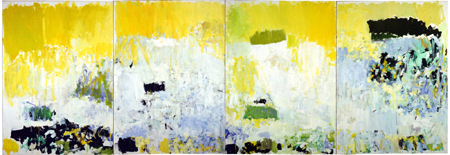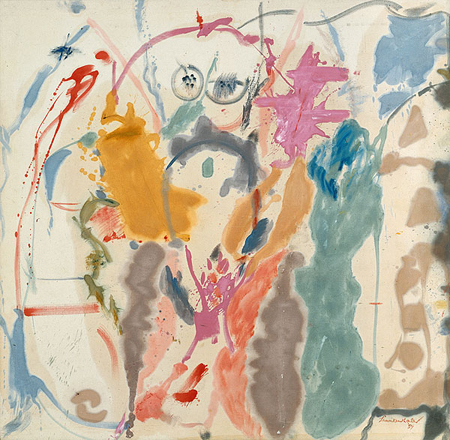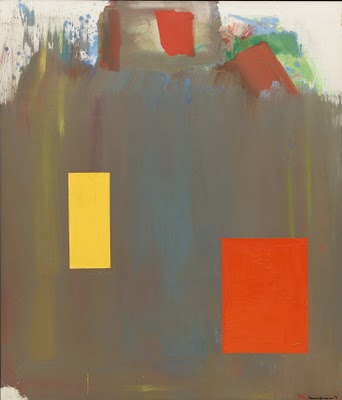MoMA’s newest exhibit, Abstract Expressionist New York presents a good overview of the NY school of abstract expressionism during its heyday in the 40’s and 50’s. I just wish the curator had included some of the best of the women in the group; Mitchell’s and Frankenthaler’s more ambitious works aren’t featured and they are not among the ‘selected artists’ on the museum’s website. Even worse, most of the linked work at the site has no images for these artists. So we’re left to google the titles for imagery.
Joan Mitchell, (American, born in Chicago. 1926-1992) “Salut Tom”, 1979, oil on canvas, approx. 110″x 78″. Corcoran Gallery of Art, Washington, DC.
Helen Frankenthaler, (American, born 1928) “Other Generations”, 1957, oil on unprimed canvas. 174.7h x 177.9 w cm. Purchased 1973 by National Gallery of Australia, Canberra.
Excerpt from Sharon Butler’s Two Coats of Paint blog about MoMA’s Abstract Expressionist New York exhibit and links from Hrag Vartanian’s blog, Hyperallergic below.
Hans Hofmann (American, born Germany, 1880–1966), “Memoria in Aeternum,” 1962, oil on canvas, 7′ x 6′ 1/8,”  The Museum of Modern Art, New York. Gift of the artist © 2010 Renate, Hans & Maria Hofmann Trust / Artists Rights Society (ARS), New York
Unfortunately, this painting isn’t actually in the show–although it’s featured in all the press materials, which undoubtedly indicates a heartbreaking, last minute decision not to include it in the exhibition. Jack Tworkov (American, born Poland, 1900–1982), “West 23rd,” 1963, oil on canvas, 60″ x 6′ 8.” The Museum of Modern Art, New York. Purchase © Estate of Jack Tworkov, courtesy Mitchell-Innes & Nash, New York.
An artist’s legacy, for better or worse, is always up for negotiation. Drawn from the collection of The Museum of Modern Art, “Abstract Expressionist New York” presents work by the usual suspects – Jackson Pollock, Mark Rothko, Barnett Newman, Franz Kline, Robert Motherwell – alongside work by less familiar artists like Jack Tworkov, Bradley Walker Tomlin, Theodoros Stamos, Adolph Gottleib, Hedda Sterne,Grace Hartigan, Romare Bearden, William Baziotes, and James Brooks. Despite the ballyhoo that the show would be more inclusive than past Ab Ex offerings, the familiar easily outmuscled the newly anointed both in terms of wall space and inclusion in the press materials. Walking through the galleries I had to remind myself that each painting had been fresh and challenging in the moment of its creation – that the artists themselves, fierce but uncertain, spent hours looking, thinking and arguing about each incremental development, each artist fighting for a place in art history.
At the gala opening reception, the artists’ heirs and estate representatives remained aware of the glory of the Abstract Expressionists’ notorious competitiveness and the legend of their hard-earned struggle. At the same time, though, they understood that the campaign to achieve and maintain eminence continued well beyond the grave. Had the museum included enough pieces? Were they well installed in a prominent location? Did they stand up to the work surrounding them?
Contemporary artists and curators, however, look at the show differently. In particular, “Abstract Expressionist New York” may move them to loosen the rationalist grip on the art world that has recently taken hold. Rather than offering didactic explanations for each aesthetic decision, artists may rediscover the value in enigmatic, emotionally-rooted work whose meaning is intuitively derived and not so easily explained. In addition, the visual language could have an impact on contemporary practice. Early Abstract Expressionist pieces – especially work by Pollock, de Kooning, Newman, Motherwell, Kline, Arshile Gorky, Lee Krasner, and Richard Pousette-Dart – relied heavily on line to convey both symbolic and emotional meaning, but autonomous line, not in service to the grid or created through masking techniques, is rarely the primary focus in painting these days. For my money, there’s nothing quite as poignant as the uneven quality of a hand-painted line. Painters might examine the show and rediscover how powerful line can be.
The best retrospectives – and Abstract Expressionist New York rates as one – are those that influence the contemporary dialogue. To get things started, MoMA has scheduled artists to give talks in the galleries.
November 4: Peter Halley
December 2: Josh Smith
January 12: Richard Tuttle
February 16: Amy Sillman
March 16: Robert Ryman
March 30: Ellen Gallagher
Free with Museum admission. Sign-up begins on a first-come first-served basis at 3:00 p.m. outside the fourth floor exhibition entrance, where the tour begins. Groups are limited to twenty-five people. Additional Gallery Talks will take place in spring 2011, with details to be announced.
“Abstract Expressionist New York: The Big Picture,” organized by Ann Temkin, with Michelle Elligott, Sarah Meister, and Paulina Pobocha. Museum of Modern Art, New York, NY. Through April 25, 2011.
Kyle Chayka reports on Hyperallergic:
- Roberta Smith, august art critic of the New York Times, calls Abstract Expressionist New York “magnificent, lavish and intelligentâ€Â yet also “myopic.â€Â The critic calls the lineup of the usual suspects “monotonousâ€Â but points out, “artists often look better in the company of their peers than in the regal isolation of museum retrospectives.â€Â And so they do! In the end, Smith says that though AbEx is a good showing, it could’ve used more diversity from lesser known voices.
- Tyler Green at Modern Art Notes is right to point out the fallacy of the show’s title: this isn’t all NYC work, and not all the artists are from NYC. The critic also investigates why Clifford Still wasn’t integrated into the thrust of the show.
- Mira Schor at her blog, A Year of Positive Thinking, contributes a long, extremely well-thought out post on the exhibition, “The fault is not in our stars, but in our brand: Abstract Expressionism at MoMA.â€Â She discusses AbEx as a pre-made canon, a brand that makes it difficult to re-insert ignored artists back into the history they contributed to.
- Carolina Miranda (AKA C-Monster) gives us the gift of a two-part WNYC audio documentary on Abstract Expressionism’s history in New York City with Perfect City: New York and the Art that Changed the World. Be sure to listen for oral histories of the Cedar Tavern and sassy Peggy Guggenheim quotes!
- The New Republic’s Jed Perl castigates the show as few others do: “the installation is so uninspired and predictable a presentation of blue-chip stuff that a visitor may be left wondering what Ann Temkin, the curator in charge, could possibly have had in mind.â€Â The fourth floor exhibition makes the AbEx works look “intellectually moribund.â€
- In a slide show essay Slate’s Fred Kaplan is struck by AbEx, but maybe not how you’d expect: “You’re staggered by how much great stuff has been languishing in the basement.â€Â Kaplan also gives much deserved attention to the galleries of photographs in the show that both exemplify and document AbEx.
- Elsewhere on HuffPo, Mark Wiener and Linda DiGusta give us a view of the opening, quoting Jerry Saltz with the zinger: “These paintings live in Queens,â€Â i.e., in storage. Some sweet opening event pics follow.
- Speaking of photos, Look Into My Owl posts a photo essay of close-ups of the works on view. I like the Gorky and the Guston.
- Here at Hyperallergic, I wrote a meditation on two particular works by Robert Motherwell, and talked about why seeing an old artist in a new light is a welcome surprise at any museum.




